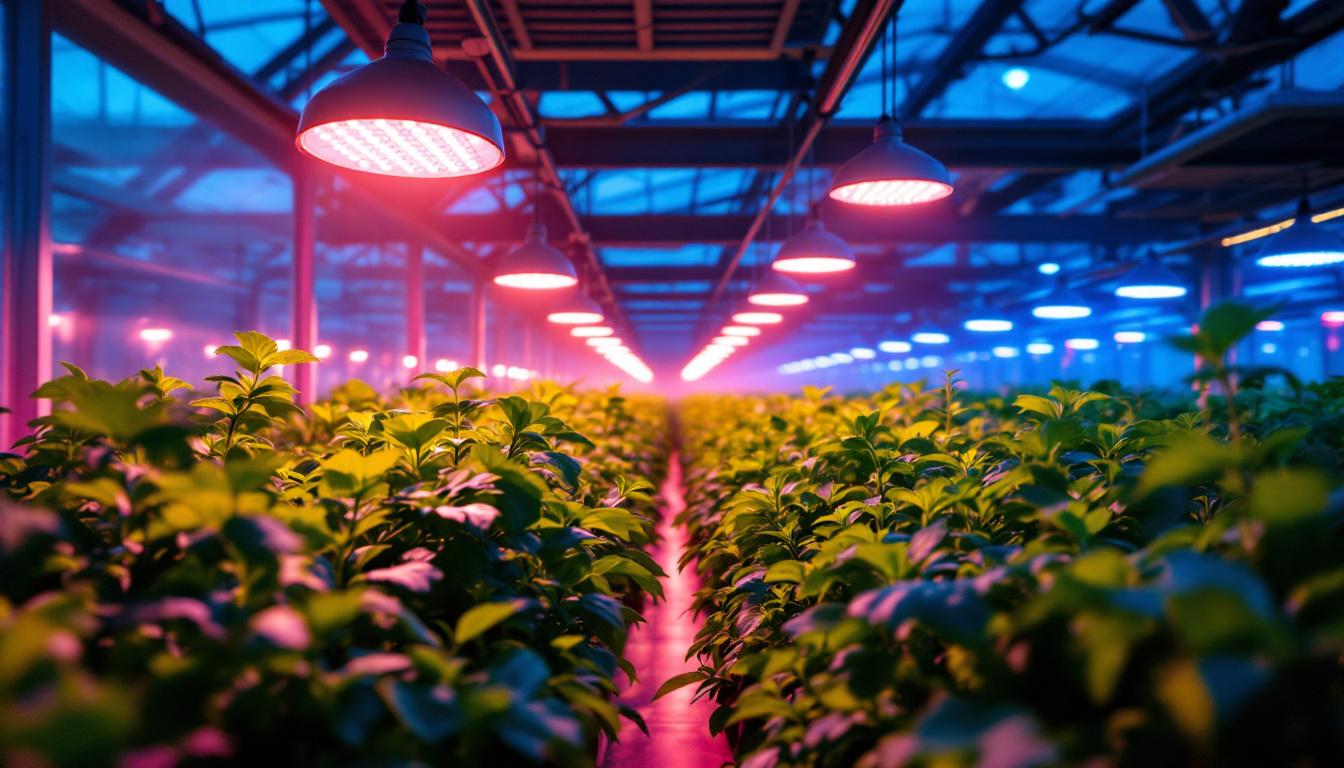
In the rapidly evolving world of horticulture, the role of lighting cannot be overstated. As more growers turn to controlled environment agriculture, the demand for efficient and effective lighting solutions has surged. LED technology has emerged as a frontrunner in this field, offering numerous advantages over traditional lighting methods. For lighting contractors, understanding the latest trends in LED greenhouse lamps is essential for staying competitive and meeting the needs of clients.
LED greenhouse lamps not only enhance plant growth but also contribute to energy savings and sustainability. This article delves into the key trends that every lighting contractor should be aware of when it comes to LED greenhouse lighting. From the latest technological advancements to the importance of spectrum tuning, these insights will help contractors provide informed recommendations to their clients.
One of the most significant advancements in LED greenhouse lighting is the development of full-spectrum lights, which mimic natural sunlight more closely than ever before. This innovation allows growers to provide their plants with the optimal light conditions needed for photosynthesis throughout all growth stages, from seedling to harvest. Additionally, these full-spectrum LEDs can be fine-tuned to emit specific wavelengths that cater to the unique needs of different plant species, promoting healthier growth and higher yields. As a result, growers are increasingly adopting these sophisticated lighting systems to maximize their production efficiency and crop quality.
Moreover, the integration of smart technology into LED greenhouse lighting systems is revolutionizing the way growers manage their environments. With the advent of IoT (Internet of Things) devices, lighting can now be controlled remotely, allowing for real-time adjustments based on environmental conditions or specific plant requirements. This level of automation not only enhances the precision of light delivery but also reduces labor costs and energy consumption. As lighting contractors become more adept at implementing these smart solutions, they can offer their clients a more comprehensive approach to greenhouse management, ultimately leading to better outcomes and increased profitability.
One of the most significant trends in LED greenhouse lighting is the integration of smart technology. Smart lighting solutions allow for remote monitoring and control of light systems, enabling growers to adjust settings based on real-time data. This not only optimizes energy usage but also enhances plant growth by providing the right light at the right time.
Contractors should familiarize themselves with various smart lighting systems that offer features such as automated dimming, spectrum adjustment, and scheduling. These systems can be integrated with environmental sensors to create a fully automated growing environment, which is increasingly appealing to modern growers. Furthermore, the ability to analyze data trends over time allows growers to fine-tune their lighting strategies, leading to improved yields and healthier plants. This data-driven approach not only enhances productivity but also empowers growers to make informed decisions, ultimately fostering a more sustainable agricultural practice.
Energy efficiency remains a top priority for growers, and LED technology excels in this area. Compared to traditional lighting options, LED lamps consume significantly less energy while providing higher light output. This not only reduces operational costs for growers but also aligns with the growing emphasis on sustainability in agriculture.
Lighting contractors should stay updated on the latest energy-efficient models and their specifications. Understanding the benefits of energy-efficient lighting can help contractors make informed recommendations that meet both the financial and environmental goals of their clients. Additionally, many LED systems are now designed to be recyclable, further minimizing their environmental impact. By promoting these eco-friendly aspects, contractors can appeal to the increasing number of consumers and businesses prioritizing sustainability, thereby enhancing their own marketability in a competitive landscape.
LED lamps are known for their longevity, often lasting up to 50,000 hours or more. This extended lifespan translates to lower replacement costs and reduced maintenance for growers. Additionally, advancements in LED technology have led to more robust designs that can withstand the unique conditions of greenhouse environments, including humidity and temperature fluctuations.
Contractors should emphasize these durability features when discussing LED options with clients. Highlighting the long-term benefits of investing in high-quality LED lighting can help growers see the value in making the switch from traditional lighting systems. Moreover, the reduced frequency of replacements not only saves money but also minimizes waste, making it a more responsible choice for the environment. As growers become more aware of the importance of sustainable practices, the durability and reliability of LED lighting will continue to be a key selling point in the transition towards more efficient agricultural operations.
Different stages of plant growth require specific light spectrums to thrive. For instance, blue light promotes vegetative growth, while red light is crucial for flowering and fruiting. LED technology allows for precise spectrum tuning, enabling contractors to provide tailored solutions that meet the specific needs of various crops.
Lighting contractors should educate themselves about the different light spectrums and their effects on plant growth. By understanding how to adjust the spectrum, contractors can help growers achieve optimal results, leading to healthier plants and higher yields.
Full-spectrum LED grow lights have gained popularity due to their ability to mimic natural sunlight. These lights provide a balanced spectrum that supports all stages of plant growth, making them a versatile choice for many growers. The convenience of using a single lighting solution for multiple growth phases can be a significant selling point for contractors.
When discussing full-spectrum options with clients, it’s essential to highlight the benefits of using these lights in terms of plant health, growth rates, and overall productivity. Providing case studies or examples of successful implementations can further reinforce the advantages of full-spectrum LED grow lights.
As the greenhouse industry becomes more specialized, the demand for customizable lighting solutions is on the rise. Growers are increasingly looking for modular systems that can be tailored to their specific needs. This trend opens up opportunities for lighting contractors to offer bespoke solutions that align with the unique requirements of each client.
Contractors should consider partnering with manufacturers that provide customizable LED options. This flexibility can be a significant selling point, allowing contractors to cater to a wide range of clients, from small-scale hobbyists to large commercial operations.
Today’s consumers are more informed and discerning than ever. They seek products that not only perform well but also enhance their overall experience. This trend extends to greenhouse lighting, where ease of use and intuitive controls are becoming increasingly important.
Lighting contractors should prioritize systems that offer user-friendly interfaces and straightforward installation processes. Demonstrating the ease of use during consultations can help build trust with clients and encourage them to invest in advanced lighting solutions.
As the market for LED greenhouse lighting continues to grow, so too does the importance of compliance with safety and performance standards. Lighting contractors must stay informed about the latest regulations and certifications that apply to LED products. This knowledge not only ensures that the products offered are safe but also enhances the credibility of the contractor.
Familiarity with standards such as UL, CE, and RoHS can help contractors guide their clients in making informed purchasing decisions. Highlighting compliance can also serve as a competitive advantage, as clients are more likely to trust contractors who prioritize safety and quality.
With the increasing focus on sustainability, environmental regulations are becoming more prevalent in the agricultural sector. Lighting contractors should be aware of any local or national regulations that pertain to energy consumption and emissions. Understanding these regulations can help contractors provide solutions that not only meet client needs but also adhere to legal requirements.
By promoting energy-efficient and environmentally friendly lighting options, contractors can position themselves as responsible partners in the agricultural sector, appealing to growers who prioritize sustainability.
The future of LED greenhouse lighting lies in its integration with other technologies, such as automation and artificial intelligence. As growers seek to optimize their operations, the ability to integrate lighting systems with other components of the growing environment will become increasingly important.
Contractors should explore partnerships with technology providers to offer comprehensive solutions that encompass lighting, climate control, and nutrient delivery systems. This holistic approach can significantly enhance the value proposition for clients, positioning contractors as leaders in the market.
The field of horticultural lighting is ripe for innovation, with ongoing research into new materials, designs, and technologies. Contractors should stay abreast of the latest developments and be prepared to adapt their offerings accordingly. This commitment to continuous learning and adaptation will be crucial for maintaining a competitive edge in the market.
Engaging with industry publications, attending trade shows, and participating in webinars can provide valuable insights into emerging trends and technologies. By staying informed, contractors can ensure they are well-equipped to meet the evolving needs of their clients.
The landscape of greenhouse lighting is changing rapidly, driven by advancements in LED technology and the growing demand for sustainable solutions. For lighting contractors, understanding these trends is essential for providing valuable insights and recommendations to clients. From smart lighting solutions to spectrum tuning and regulatory compliance, staying informed about the latest developments will empower contractors to thrive in this dynamic market.
By embracing innovation and prioritizing customer needs, lighting contractors can position themselves as trusted partners in the horticultural sector. As the industry continues to evolve, those who adapt and grow alongside it will undoubtedly reap the rewards.
Ready to elevate your lighting game and stay ahead of the curve in the greenhouse lighting industry? At LumenWholesale, we provide lighting contractors like you with the cutting-edge LED solutions discussed in this article. Our commitment to quality and affordability ensures that you have access to the best spec-grade lighting products at wholesale prices, without the burden of inflated markups. Take advantage of our hassle-free bulk buying and free shipping to get premium lighting at the best value for all your projects. Don’t compromise on quality or cost—choose LumenWholesale for a seamless blend of excellence and convenience. Discover our extensive selection and start transforming your lighting approach today by visiting Wholesale Lighting at the Best Value.

Discover how outside LED lighting can enhance your business’s profitability in our comprehensive guide tailored for lighting contractors.

Explore the advantages and drawbacks of using vehicle wire running tools for lighting contractors.

Discover the transformative impact of 8-foot LED lights on the lighting industry.

Discover the latest trends in LED flush mount lighting that every contractor should know.